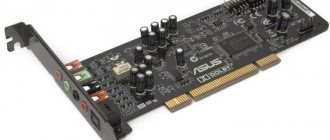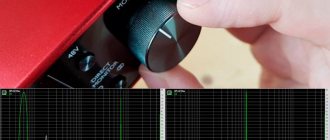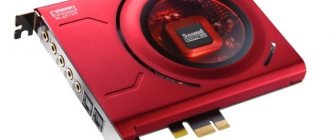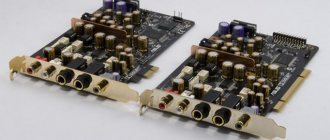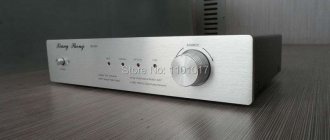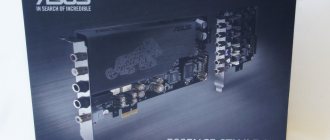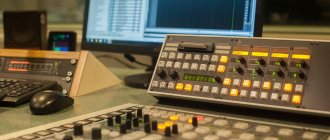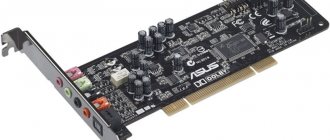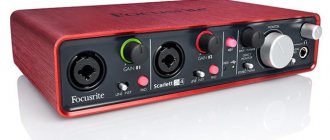Inexpensive external sound cards based on top-end chips are still in short supply, and the appearance of the ASUS U7 model with CS4398 deserves close attention.
Until recently, only the Creative X-Fi HD USB model on the AKM4396 and the more expensive professional cards E-MU0204 and E-MU 0404 could be seen on the market. Other solutions, like ESI Dr.Dac Prime, already cost $500 (in the Russian market). This year, ASUS is pleased with the release of not only the advanced external DAC Essence STU, but also the budget U7 card for $100.
The main features of the U7 are, of course, the use of a CS4398 for front output, 7.1 multi-channel playback, ASIO support and 192 kHz high sample rate playback via USB. And all this in a lightweight, compact, USB-powered design. In fact, the ideal companion for mobile use with a laptop.
Appearance of ASUS U7
The U7 has a plastic body, making the card very light. On the top panel there is a volume control, which also provides switching between output modes: headphones and line output.
On the front panel there are mini-jack connectors with a headphone output and a line/microphone input. The push-button control adjusts the input volume level. Selecting the mode: line or microphone is done in the U7 driver panel.
The rear panel contains analog outputs, a combined SPDIF output (electrical coaxial and optical mini TOSLINK) and a USB connector. The front analog output is made on RCA connectors, the rest are mini-jacks (to save space). There is a USB 1.0/2.0 switch on the bottom panel.
The U7 is only slightly larger than the Colorfly C4 Pro player and 2.5-inch external hard drive.
In terms of carrying, it’s an excellent option – it takes up little space and the weight is minimal. For systems based on tablets and laptops, the ASUS U7 is just right.
Functionality
The Asus Xonar U7 has three main functions: digital-to-analog and analog-to-digital conversion and sound reinforcement.
Let's look at the digital-to-analog part. When connected to a PC, the card will convert digital data into an audio signal. The only source for it is USB from a computer; there are no optical or coaxial digital inputs. The Xonar U7 is not suitable for connecting, for example, to a media player as an external DAC.
The device is practically omnivorous. It is capable of working with data of 44.1/48/88.2/96/172.4/192 KHz with a bit depth of 16/24 bits. ASIO mode supported. The basis of the DAC is the Cirrus Logic CS4398 chip.
The audio card works with Dolby Home Theater V4, through an additional control panel you can select one of the preset sound processing presets or create your own using a graphic equalizer, as well as systems for simulating multi-channels and increasing speech intelligibility.
There are two output options to choose from - headphones and line, which can be used both with a pre-amplifier and for active speakers. They are switched either software (via Xonar Audio Center) or hardware by pressing the volume control knob. The fact of pressing is clearly recognized, but the principle itself is not entirely good. Imagine what will happen if at night, with the active speakers forgotten and turned on, the sound goes to the line output instead of the headphones... There are prerequisites for such a scenario, because the volume control knob is smooth, for the convenience of its rotation there is only a spherical “dent”, which you can press a little stronger than necessary - a couple of trifles.
The headphone amplifier is capable of driving models with a resistance of up to 150 Ohms, and Xonar Audio Center has a menu for switching the gain strength, with three values to choose from. The amplifier handled the 32-ohm Sennheiser HD 490 without any problems, providing comfortable volume without distortion.
Asus Xonar U7 can also transmit digital data to coaxial or optical outputs. This is useful for connecting your computer to an external decoder/amplifier, such as a home theater system.
An analog signal source can be connected to the front panel input, which will be (for example, in the case of a microphone) pre-amplified and digitized in accordance with the parameters specified in the driver. By the way, they fully comply with the playback parameters.
Probably, the Asus Xonar U7 should not be considered as a serious solution for sound recording, at least because of the 3.5 mm input implementation, but sound input for oral communication is not satisfactory; Xonar Audio Center even has four voice modifiers.
The manufacturer did not provide a standard upgrade option without voiding the warranty. All components are soldered onto the board.
Inside ASUS U7
Inside we can observe a fairly dense installation.
Everything is done carefully. In terms of the elements used, the card is closest to the ASUS Xonar DX, but is a more advanced option due to the use of separate generators for 44 and 48 kHz frequency grids. There are no particularly high-quality elements soldered on the board, so seasoned audiophiles will inevitably criticize the full potential and that only after the intervention of a soldering iron will the sound be decent - similar to the Creative X-Fi HD USB.
The board is actively dotted with elements on both sides.
The CM6632A is responsible for communication with USB, which differs from the CM6631A (used in STU) in its multi-channel nature; while there are only two inputs and two outputs, the 6632A has four input channels and 10 output channels. The second distinctive feature is support for DSD stream, which, however, is not used in U7, but may appear in future products. The CM6632A is also responsible for the SPDIF output. For frequencies that are multiples of 44 and 48 kHz, separate generators can be seen.
The front channels are served by the CS4398, which is also used in cards such as the E-MU m series (1212m/1616m/1820m), LynxTwo, as well as in ASUS Xonar DX and Colorfly C4 Pro. At the moment, this is the flagship of Cirrius Logic. The main characteristics of the CS4398 are signal noise 120 dB, harmonic distortion level 107 dB (0.0003%).
The CS5361 is responsible for recording with parameters of 114 dB signal-to-noise and a harmonic distortion level of 105 dB (0.0006%).
The remaining channels are covered by a six-channel CS4362 with parameters of 114 dB signal/noise and a harmonic distortion level of -100 dB (0.001%). When using budget multi-channel acoustics, such a DAC is more than enough.
In the latest Creative products of the Z and U7 line, you can see smaller op-amps with barely legible markings.
Creative Sound Blaster X-Fi HD vs. Asus Xonar U7
Two USB sound cards with high-quality DACs In today's material we compare two interesting sound cards: Creative Sound Blaster X-Fi HD vs. Asus Xonar U7. These are two products that are close in price and capabilities, in which the emphasis was placed on high-quality converters. Moreover, both cards at the time of writing were on sale at a very low price, a little over 3 thousand rubles.
On the forum, the Asus Xonar U7 was called the “optimal choice” in absentia, based on a review of photographs and specifications. Many people completely in vain forget about the need to directly compare devices by sound. Most are also unable to correctly interpret measurement results.
Name
- Creative Sound Blaster X-Fi HD
- Asus Xonar U7
The Creative card has a confusing name, as it is not related to the X-Fi cards and is not related to the Titanium HD card. As a result, the card's release went unnoticed. This product is not known at all to anyone except some computer audio enthusiasts.
Asus Xonar U7 also has an unclear name. The rather old U1 and U3 cards are budget products with integrated sound quality. U7 has no relation to previous products in this series.
For brevity, we will henceforth simply refer to the cards as Creative.
and
Asus
.
Price
- Creative:
3700 rub. - Asus:
3100 rub.
| Creative | Asus |
| Average price according to Yandex.Market | |
| T-6500990 | T-10405889 |
| Offers based on Yandex.Market data | |
| L-6500990-10 | L-10405889-10 |
The cards cost almost the same, the difference in absolute values in price is not serious. More importantly, such an affordable price makes them interesting to a wide range of buyers. They have virtually no competitors among USB cards!
At the same time, the Asus card appeared quite recently. The manufacturer also reports that the Asus Xonar U7 Echelon Edition model will soon appear with an army camouflage paint job and more functional drivers.
The target audience
- Creative:
mass, audiophiles - Asus:
mainstream, home theater
The Creative model is a card with full-size TRS headphone and microphone connectors. Interestingly, there is a Phono input for digitizing vinyl, with grounding. It also works in normal linear input mode. THX and other proprietary processing are software only. For movies, there is an optical digital output for connecting a 5.1 receiver with a decoder.
You can connect 7.1 analog speakers to the Asus card using minijack connectors. The emphasis is on the included Dolby software. Digital output - combined, optical/coaxial. Both cards have a line input, but in the case of Asus the line input is combined with a microphone input, which is quite difficult to guess.
It remains a mystery why it was necessary to load both cards with so many functions and software in addition to a high-quality output. This inevitably blurs the audience and distracts from the main advantage of the cards, namely a high-quality DAC . All the other dregs are available in abundance in almost any sound card. In the description of sound cards and in the design of the boxes, as they say, “you can’t see the forest for the trees.” It is not clear who will organize a 7.1 cinema around a computer or laptop - this is inconvenient and in practice unclaimed. Fortunately, the user does not overpay much for all these additional functions, since the price of the cards is very low.
Volume knob
- Creative:
Miniature metal volume knob with original layout. There is a Mute function when you press the knob. Using the handle is not very convenient, since it is located very close to the surface of the table: the fingers are located in a very unusual position and slip over the surface. - Asus:
The smooth handle is recessed into the body. Pressing the knob turns off the speakers in favor of the headphones and vice versa. It is inconvenient to use: considerable effort is required, otherwise the finger will slip. The recess for the finger is made for beauty - it is much easier to adjust by pressing your finger where there is no recess.
In both cases, a non-stop digital regulator is used. The ergonomics of the regulators are very conditional. Due to the combination of the functions of a regulator and a button, the Asus regulator plays quite noticeably. Many users would prefer to remove the button, but so that there is no backlash. Also, Asus's recessed dial makes it easy to carry the audio interface. In all other cases, this decision looks controversial.
Illuminations
- Creative:
Blue LED on top panel - Asus:
3 signal LEDs on top panel
The activity indicator on the Creative card lights up brighter. In principle, for most this will not be a problem. But we had a strong desire to seal it with duct tape so that it would not be an eyesore and would not be constantly visible in peripheral vision.
Headphone output location
- Creative:
front - Asus:
front
Both cards have convenient connectors.
Filling
- Creative:
DSP Creative CA0189-2AG, 2-channel DAC AKM AK4396 (123 dB), 2-channel ADC CS5361 (114 dB). - Asus:
DSP CM6632A, 2-channel DAC Cirrus Logic CS4398 (120 dB), 6-channel DAC Cirrus Logic CS4362A (114 dB), 2-channel ADC CS5361 (114 dB).
The contents of both cards are very interesting. And this is the main feature of the cards, against which everything else no longer interests anyone. The Cirrus Logic CS4398 DAC is considered a higher class than the AKM AK4396.
All Creative USB sound cards feature a proprietary CA0189-2AG RISC processor with a frequency of 100 MHz. Unlike the usual Creative DSPs, this chip does not have hardware audio processing. Its purpose is a fast USB 2.0 controller and a multi-channel interface to full-fledged I²S/I²C converter chips, such as those used by Cirrus Logic and AKM. There are two crystal oscillators soldered on the board.
Asus uses an interesting CM6632A chip, which supports both HDA codecs and I²S/I²C converters. Number of channels - 8+2 (analog + digital) output and 2+2 input. There is support for 192 kHz frequency. The chip can be clocked from three generators at once, 12, 24.5 and 22.5 MHz, which is what the creators of the card used. The decision to throw pasta from one end of the board with the DAC to the other with connectors remains not very clear.
All processing in both cards is carried out exclusively at the software level. The maximum data rate of 96 kHz isn't much of an issue since 192 kHz content is virtually non-existent. Hi-Res did not give anything to ordinary users and did not reach the masses, and aesthetes and Hi-End lovers are unlikely to be interested in sound cards for $100.
Auto switch to headphones
- Creative:
yes - Asus:
yes
When plugged into the headphone jack, the speakers are turned off. This feature was first implemented in integrated audio, as part of the AC'97 and HDA standard. First, the detection of connected headphones was carried out by impedance, and then by a mechanical sensor. External cards with good converters are not inferior to integrated sound in this regard. However, in practice this can cause problems.
Bundled software
- Creative:
software set on disk, driver update on manufacturer's website - Asus:
identical installation kit on CD and on the manufacturer's website
The software disc is the same as all other Creative products.
The appearance and contents of the Entertainment Console of the X-Fi card have already been described more than once in our materials. The Audio Control Panel comes included right away and allows you to control absolutely all settings without the back and forth of a graphical menu, with the exception of the equalizer. Creative Volume Panel - it is not clear why this program is needed, it is supplied for assortment. An important difference between drivers for XP: they provide a choice of frequency and bit depth directly from the Entertainment Console. The frequency is limited to a choice of 48 or 96 kHz, regardless of the OS. This choice is typical for all Creative USB cards.
The Asus map panel is designed very strangely. Parameters can only be selected through the context menu with the right mouse button!
There is an interesting option for setting the headphone output volume limit.
In the jungle of settings, Asus has a separate option - Dolby Home Theater v4, which seems to have surpassed the number of “improvers” of Creative cards.
44 kHz support
- Creative:
no - Asus:
yes
The Creative card contains two crystal oscillators and also has 44 kHz support at the DSP level. However, drivers for neither Windows XP nor Windows 7/8 do not support operation in 44 kHz mode: in the device settings you can only set 48 kHz or 96 kHz. In a card for audiophiles, this indicates either inadequacy or complete incompetence of the developers. To listen to music, 99.9% of cases use a frequency of 44 kHz. We are looking forward to comments from the map developers themselves.
The Asus card supports all frequencies: 44, 48, 88, 96, 192 kHz.
Availability of ASIO driver
- Creative:
no - Asus:
yes
The lack of an ASIO driver for Creative cards is beyond our understanding. The best listening option for a Creative card is the WASAPI interface and software resampling in the player. Conversion from 44 kHz to 48 or 96 will always be forced by the Windows sound engine, or you need to select the conversion on the fly in the media player. For example, in the foobar 2000 player:
Sound from speakers
Listening was carried out on active monitors Adam S2.5A and Adam ARTist 5. For comparison, the very well-known sound cards E-MU 1616M (CS4398) and E-MU 0204 USB (AK4396) were used.
First surprise: all the cards play completely differently! In first place in terms of sound quality is the E-MU 1616M card, in second place is the E-MU 0204 USB, in third place is the Creative Sound Blaster X-Fi HD, and in fourth place is the Asus Xonar U7.
The sound of the Asus card is least similar to the E-MU 1616M (despite the installed identical DACs). The problem with distortion at Asus is to blame, since we know for sure that the 1616M card has an unrivaled analog output implementation. This includes a measured 120 dB signal/noise, a measured 0.0003% distortion, and a wonderful clear sound experience. The 1616M is not much inferior in sound to the best implementations of rack-mounted studio devices, comparable to Pro Tools HD and Lynx Aurora, so we confidently choose the 1616M sound as a reference for devices in the category under $150. E-MU 0204 USB is inferior quite a bit. X-Fi HD sounds brighter and more accentuated on the high frequencies, therefore, despite all its effectiveness, it is a little further from the original sound. The Xonar U7 really disappointed us with its poor highs and rather sluggish sound. Perhaps this problem can be solved by flashing the firmware or drivers; We will definitely clarify this issue with the manufacturer. In any case, there should not be 0.01% distortion. Both the digital and analog parts of the card are capable of more.
Let's also criticize Creative for the lack of a 44 kHz mode. This is simply inexplicable, nonsense! How can you make an audiophile card, install two crystal oscillators and prohibit it from operating at 44 kHz? Don't provide the user with an ASIO driver that bypasses Windows? This is simply the wildest incompetence of the developers. The E-MU 0204 USB - a device for the same money - has no trace of such problems! There is a feeling that one division of the Creative company is mercilessly competing with another: persistently developing a bicycle with square wheels, when in the next room a racing sports car has long been developed and tested.
Sound in headphones
We used high-impedance headphones Sennheiser HD600 (300 Ohm) and Beyerdynamic DT990 Pro (250 Ohm).
The volume is sufficient in both cases, but the Asus card has practically no headroom. Creative was able to surprise us once again. In terms of sound quality, the places were distributed as follows: in first place is E-MU 1616M, in second place is Sound Blaster X-Fi HD, in third place is E-MU 0204 USB, and in fourth place is Asus Xonar U7. The professional interface E-MU 0204 USB, in principle, performed well, but X-Fi HD looked like a clear favorite against its background and had a significantly larger volume headroom. The Asus Xonar U7 card is the quietest, but its volume increases sharply when processing is turned on. Perhaps this was done intentionally so that there was a so-called headroom for Dolby technologies and other auto-equalizers. Thus, the Asus card is the least suitable for simply listening to music; its emphasis is placed precisely on the effectiveness of processing. The squeals and hoots of the card fans remain completely incomprehensible to us.
Measurements in RMAA
- Creative: RMAA Excellent
| Device under test | Sound Blaster X-Fi HD |
| Operating mode | 24-bit, 48 kHz |
| Audio Interface | WASAPI |
| Signal route | External loopback (line-out - line-in) |
| RMAA version | 6.3.0 Pro |
| Filter 20 Hz - 20 kHz | Yes |
| Signal normalization | Yes |
| Level change | −0.3 dB / −0.3 dB |
| Mono mode | No |
| Calibration signal frequency, Hz | 1000 |
| Polarity | correct/correct |
| Frequency response unevenness (in the range 40 Hz - 15 kHz), dB | +0,03, −0,08 | Great |
| Noise level, dB (A) | −108,3 | Great |
| Dynamic range, dB (A) | 108,2 | Great |
| Harmonic distortion, % | 0,0031 | Very good |
| Harmonic distortion + noise, dB (A) | −87,5 | Fine |
| Intermodulation distortion + noise, % | 0,0037 | Great |
| Interpenetration of channels, dB | −100,6 | Great |
| Intermodulation at 10 kHz, % | 0,0057 | Great |
| Overall rating | Great | |
- Asus: RMAA Excellent
| Device under test | Asus U7 |
| Operating mode | 24 bit, 44 kHz |
| Audio Interface | ASIO |
| Signal route | External loopback (line-out - line-in) |
| RMAA version | 6.3.0 Pro |
| Filter 20 Hz - 20 kHz | Yes |
| Signal normalization | Yes |
| Level change | −0.3 dB / −0.3 dB |
| Mono mode | No |
| Calibration signal frequency, Hz | 1000 |
| Polarity | correct/correct |
| Frequency response unevenness (in the range 40 Hz - 15 kHz), dB | +0,03, −0,03 | Great |
| Noise level, dB (A) | −111,2 | Great |
| Dynamic range, dB (A) | 111,3 | Great |
| Harmonic distortion, % | 0,0033 | Very good |
| Harmonic distortion + noise, dB (A) | −87,3 | Fine |
| Intermodulation distortion + noise, % | 0,0062 | Great |
| Interpenetration of channels, dB | −102,4 | Great |
| Intermodulation at 10 kHz, % | 0,010 | Great |
| Overall rating | Great | |
Tests at the RMAA gave an "Excellent" rating. This means that the devices have no obvious flaws. It doesn't mean anything anymore. (But as soon as artificial intelligence makes human measurement analysis unnecessary, we'll be the first to let you know!)
Both cards were tested through their own path, as they have the same high-quality CS5361 ADC.
Asus is slightly better in noise, and Creative is slightly better in distortion. We were concerned about the appearance of the Asus graph in the floating tone intermodulation test: usually anomalies in this test indicate frequency conversion or some other digital processing. We rechecked all the settings several times. The results do not change. We conducted additional tests on Windows XP and Windows 7 that were completely installed. We used the latest drivers and the latest firmware. There is only one result: the Asus card has about 10 times more distortion at high frequencies.
Our readers asked to measure only the output
to eliminate possible ADC surprises or other problems at the line input. On the advice of Roman Kuznetsov, we used an Asus laptop, which was powered by a battery. Thus, the earth loop was broken, and the spectra became very clear. Although the result based on suggestions is still far from ideal.
One way or another, measurements using the E-MU1616M card gave a significantly better result! We note the low signal level from the Asus line input, which did not allow us to demonstrate high signal-to-noise values.
- Asus U7
| Frequency response unevenness (in the range 40 Hz - 15 kHz), dB | +0,04, −0,16 | Very good |
| Noise level, dB (A) | −110,8 | Great |
| Dynamic range, dB (A) | 111,3 | Great |
| Harmonic distortion, % | 0,0005 | Great |
| Harmonic distortion + noise, dB (A) | −101,6 | Great |
| Intermodulation distortion + noise, % | 0,0012 | Great |
| Interpenetration of channels, dB | −103,7 | Great |
| Intermodulation at 10 kHz, % | 0,0028 | Great |
| Overall rating | Very good |
- Creative X-Fi HD
| Frequency response unevenness (in the range 40 Hz - 15 kHz), dB | +0,02, −0,31 | Very good |
| Noise level, dB (A) | −114,7 | Great |
| Dynamic range, dB (A) | 114,9 | Great |
| Harmonic distortion, % | 0,0036 | Very good |
| Harmonic distortion + noise, dB (A) | −86,3 | Fine |
| Intermodulation distortion + noise, % | 0,0027 | Great |
| Interpenetration of channels, dB | −107,0 | Great |
| Intermodulation at 10 kHz, % | 0,0031 | Great |
| Overall rating | Very good |
- E-MU 0204
| Frequency response unevenness (in the range 40 Hz - 15 kHz), dB | −0,06, −0,27 | Very good |
| Noise level, dB (A) | −115,4 | Great |
| Dynamic range, dB (A) | 115,2 | Great |
| Harmonic distortion, % | 0,0028 | Great |
| Harmonic distortion + noise, dB (A) | −88,5 | Fine |
| Intermodulation distortion + noise, % | 0,0024 | Great |
| Interpenetration of channels, dB | −106,4 | Great |
| Intermodulation at 10 kHz, % | 0,0032 | Great |
| Overall rating | Very good |
conclusions
There is no winner in the duel between Creative and Asus. Despite all the powerful potential of the components, we cannot recommend any of the sound cards participating in testing for high-quality music listening! At least until all the bugs are fixed. At the moment, the cards are a frankly unfinished product, on which tons of meaningless and useless functions are hung, and tons of marketoid nonsense are used to promote them: some 8 channels and 96-192 kHz... THX, Dolby HTV4... with the inability to work normally in one the simplest and most useful mode for people: “stereo 16/44”.
As long as the situation described in the article persists, no one will be surprised by the popularity among music lovers of inexpensive professional sound cards for the sole purpose of high-quality listening to music in a single 16-bit 44 kHz mode. It’s very funny to see the attempts of users of the tested cards to solve problems by selecting interconnect cables or “warming up” on sacred signal types. The most reasonable option seems to us to be correcting bottlenecks in the sound cards themselves.
Driver U7
The driver is based on the Xonar Phoebus. If you do not ignore the message that all settings are called up using a separate mouse button, then mastering the driver will be simple and fast.
The Dolby software did not install on the old system, but everything was installed on a clean system without problems, albeit with an updated driver from the ASUS website.
The most interesting is the dynamic equalizer, which constantly monitors the overall frequency balance and accordingly adjusts the sound to the selected preset. This is a useful function for listening to homemade compositions from social media. networks and YouTube, where the frequency balance is obviously crooked. This is a kind of alternative to the SBX Pro effects from Creative.
All Xear effects work only on analog outputs; effects are not applicable to digital output. On the one hand, it’s a pity that the U7 cannot be used as an inexpensive USB-SPDIF converter for an external DAC with a set of “improvers,” on the other hand, you won’t have to worry about data quality.
In the driver panel there is an “ASIO” button to call up the ASIO settings panel - bit depth (16 and 24 bits) and latency level. As tests have shown, the delay of the card is close to the selected ones, although it is not very accurate, the delay value varies slightly from time to time. It's a bit of a pity that the digital output is not tied to ASIO in any way.
The digital output is always visible in the system, and when it is used, the corresponding indicator on the top panel of U7 lights up. The situation with the name of the device for analog outputs is a little ambiguous; by default, when selecting the headphone mode, “Headphones (2-Xonar U7)” is displayed, and for speakers, respectively, “Speakers (2-Xonar U7)”. As soon as you click on the mode switch button, one device is removed from the system, and another appears, and during playback, for example through foobar2000, this leads to the playback stopping and the requirement to select a playback device. Additionally, when you connect or disconnect headphones, the modes also change. Line and microphone inputs appear in the system only when physically connected to the socket. On the one hand, this approach allows you to unload the lists of unused inputs, on the other hand, all connections must be made when the sound programs are not working at the time.
external audio interface ASUS Xonar U7
In the last issue, we tested the Xonar Essence III USB DAC, the senior in the ASUS line of digital-to-analog converters. The device is interesting both in design and sound, but it is by no means cheap and therefore certainly not widespread. However, it seems to me that its developers did not count on large sales volumes; this model is designed primarily to show the technological potential of the company, and it succeeded. However, you also need to be able to create an inexpensive product that will be in mass demand. Now we will get acquainted with just such a device - the Xonar U7 external audio interface, one of the most affordable from ASUS.
The model is designed to work together with laptops, which determined many of its features. For example, small dimensions and weight - it’s quite possible to take it with you on the road. Another one is the lack of other digital input interfaces other than USB. But there is a digital output (coaxial and optical on one RCA connector) - this will allow you to use the U7 as a USB>S/PDIF converter for connecting to an external DAC or receiver. An analog input (3.5 mm) is also available, and it can be used both as a microphone and as a line input - the sensitivity is adjusted by a “swing” on the front panel. I doubt that anyone will use it to digitize analog recordings, but it might be useful for a Skype headset.
The U7 is powered via the USB bus - for mobile use, on the one hand, this is a benefit, since you don’t have to carry an adapter with you. On the other hand, the laptop's battery life will likely decrease. To what extent, this can only be understood from personal experience, since there is no information about energy consumption in the documentation. For sound, an external linear power supply would probably be more useful, but such interfaces are usually equipped with simple switching adapters, so the power received via USB from the laptop is unlikely to be of worse quality.
SUBTLETS OF THE THEATER
Not long ago I wrote that the line between USB DACs and external sound cards has become almost indistinguishable. However, the manufacturer himself classifies the U7 as the second type of device. The main reason for this is the 7.1 analog outputs and the Dolby Home Theater V4 software package, which is installed on the computer along with drivers. That is, the device can be used not only for playing music, but also for multi-channel dubbing of films. True, here too there is a clear priority for stereo: the outputs of the front channels, which are also used when playing music in stereo, are made on RCA connectors, the remaining channels are on thin (3.5 mm) mini-jacks. However, it is precisely these connectors that are usually equipped with inexpensive sets of computer speakers, so there should be no problems with switching. However, the decoding function is limited only to Dolby Digital, but the presence of an S/PDIF output makes it possible to subsequently connect to the receiver.
But the stereophonic part of the device, on the contrary, inspires certain hopes. And not only because it has output to “normal” connectors, but also because it is built on a Cirrus Logic CS4398 DAC - the same one that is used in our editorial CD player Bryston BCD-1. It is clear that the final sound of the device is not determined by one chip, that its wiring is also very important, but the U7 developers could have found a cheaper chip, but they did not do this. I will also note the Hyper Grounding technology - its essence is that analog and digital signals are routed across different layers of the board, separated by a double screen. I think it’s not without this that a real signal-to-noise ratio of 114 dB was achieved (for comparison: for most integrated interfaces it does not exceed 90 dB).
TWIST AND PUSH
This is how you can briefly describe the card's control algorithm: adjusting the volume and switching between the linear output or headphones is carried out by a large round knob, slightly recessed into the case. It is also the main decoration of the device, except, of course, for the three LEDs on the top panel - they show active outputs, both analog and S/PDIF.
At the bottom there is a USB mode microswitch - v1.0 or v2.0 - all ASUS DACs have a similar switch. By default, it is set to the second position, and only owners of very old computers or those who, for some fundamental reasons, do not want to install drivers and are going to be content with input signals no higher than 48 kHz should worry about changing it.
The drivers from the included disk were installed without problems, and the device was able to receive digital streams up to 192 kHz/24 bits, and in the selection of output interfaces section of the Foobar2000 player, an ASIO item for U7 appeared. And in the Windows notification area, an icon appeared that allows you to open the Xear Audio Center control panel with many settings, processing, profiles, a Dolby Home Theater V4 section, as well as controls for the overall level and balance between channels, the latter also operating when playing through ASIO. However, during testing they were turned up to the top position to eliminate the effect of this digital adjustment on the sound. I don’t think it’s very significant, but it’s better to be safe.
I usually don’t expect surprises from budget equipment, since they happen infrequently. But here I was pleasantly surprised. U7 plays comfortably. The main thing is that there is no specific digital dirt inherent in audio interfaces integrated into motherboards. The elaboration of details is sufficient, but not excessive - the device does not extract information that should not be heard. The 44.1 kHz/16-bit material sometimes seems smoothed out, one might say sterile - this is the sound that happens with inexpensive class D amplifiers), but as the sampling frequency increases, this feeling goes away, and at 192 kHz/24-bit the sound takes on an openness, an illusion The "veil" almost disappears. However, some lack of realism is still felt here. The scene is built believably as a whole, although the focus of individual instruments is not always sufficient. Bass lines have been slightly simplified. But all these quibbles can arise only when comparing the U7 with the reference DAC and if you forget about the tempting price of this model. If you listen to the ASUS card without comparing it with other sources, it does not cause either rejection or regret.
The built-in headphone amplifier is capable of delivering half the output voltage of the Essence One and Essence III, but the high-impedance headphones rock with confidence. However, you can notice that the resolution at the edges of the range is somewhat reduced, as well as the dynamics. Low-impedance phones play incomparably more freely and effectively. Well, this device is intended for them. u
PLEASED
Comfortable sound. USB driver with ASIO support. Can be used as a USB>S/PDIF converter. Attractive price.
DISAPPOINTED
There is no connector for external power, which eliminates the possibility of improving the sound.
- COMPONENTS
- Computer digital transport with PCI audio interface Asus Essence ST
- External DAC PS Audio PerfectWave MkII ($4000)
- Yamaha Soavo-1 acoustic systems ($2000)
- Sennheiser HD 650 Headphones ($450)
- Headphones AKG K 480 NC (€180)
- Integrated amplifier Musical Fidelity A5-INT ($2000)
- Interconnect cables Musical Wire Cadence Signature RCA ($1000), acoustic cables Tchernov Cable Classic IC ($40/m)
- Digital cables: Audioquest Cinnamon USB 1.5 m ($76), Furutech FX-Alpha-Ag coaxial 1 m ($150), Oehlbach XXL 80 optical ($71)
ASUS Xonar U7
Manufacturer: ASUSTeK Computer Inc. (Taiwan)
www.asus.com/ru
Configuration: 7.1 || Signal-to-noise ratio (A-weighted) at line output: 114 dB || Line Output THD+ Noise (A-weighted): 0.0006% || Output Voltage (RMS): Line Out 1.0V, Headphone Out 1.3V || Frequency range (-3 dB, 24 bit/96 kHz): 10 - 46000 Hz || Input Signals (all digital inputs): 44.1/48/88.2/96/176.4/192 kHz @ 16/24 bits || Inputs: USB 2.0, analog for microphone (combined with line input) || Outputs: analog stereo (2 x RCA), analog 5.1 (3.5 mm), headphones (3.5 mm), S/PDIF (coaxial, optical) || Operating systems: Windows XP, 7, 8, Mac OS X || Support: ASIO v2.0 || Home cinema software: Dolby Home Theater V4 || Dimensions: 130 x 80 x 25 mm || Weight (with packaging): 0.69 kg || Included: RCA > Toslink adapter, USB cable, CD-ROM with drivers, user manual || Price: 4000 rub.
- MICROCIRCUITS
- 1. Processor: C-Media CM6632A
- 2. DACs: Cirrus Logic CS4398 (2.0), Cirrus Logic CS4362 (5.1)
- MUSIC WE LISTENED TO
- 1. Collection “Burmeister Reference CD II”. FLAC 44.1 kHz/16 bit
- 2. Beth Hart & Joe Bonamassa, “Don't Explain.” FLAC 44.1 kHz/16 bit
- 3. “Tutti!” Orchestral sampler. FLAC 44.1 kHz/16 bit
- 4. McIntosh Spectacular Reference. FLAC 192 kHz/24 bit
- 5. Deep Purple, “Machine Head.” FLAC 96 kHz/24 bit
- 6. Slowly Rolling Camera, “Slowly Rolling Camera.” FLAC 48 kHz/24 bit
share
Tags: ASUSPersonal experience
ASUS U7 in action
The device is compact and can become a laptop companion or something like a portable sound card for work. For those who dream of using the U7 as a portable DAC while traveling (buses, subways, etc.), the U7 is not very convenient, because USB and headphone connections are made on the long sides and, accordingly, require more free space in the compartment with U7. The iBasso D-Zero is much more convenient in such a situation and can be placed even in a regular clothing pocket, while the U7 cannot. The U7 should be considered a mobile device that is not used on the go. So, for example, the U7 was more than successfully used when setting up the acoustics in a car, with a connected external measuring microphone running a tablet running Windows 7 (unfortunately, everything related to measurements under the latest Windows systems requires ASIO, otherwise the system mixer significantly destroys the results and in this regard, U7 has a significant advantage over X-Fi HD USB). U7 can work not only in the latest systems, but also in the old and still current Windows XP. Under XP there are no effects from Dolby, but there are additional effects from Xear in the form of an equalizer, bass control, etc., which are absent under Windows 7 in Xear and are implemented in Dolby. There were no problems when playing audio content via Wasapi and ASIO. The stop-free regulator rotates freely, there were no complaints about reliability. The multichannel output is especially worth noting, because... Recently, it is becoming less and less common in laptops, giving way to one four-pin headset connector or a pair of connectors for a microphone and headphones. You can count the number of multichannel sound cards on the market on one hand and most of them are professional cards with bells and whistles that the average consumer does not need. In this regard, the U7 multi-channel output will most likely be in high demand for those who use a laptop at home and have multi-channel acoustics.
Subjective sound
DAC U7 vs Creative Zx, iBasso D-Zero
Comparing a device on a high-class path and with opponents of a higher class certainly leads to a logical result and is of academic interest for an unlikely miracle. It is more appropriate in this case to use systems of the class that are used by ordinary users, potential owners of U7. For this, JetBalance JB 381 of the second modification were taken from the bins. The opponents are Creative Zx, iBasso D-Zero and the built-in sound output of a Lenovo laptop.
It was not possible to give a clear preference between the U7 and Zx; both cards provide good sound. Although D-Zero practically did not lag behind, it stood out due to the presence of background interference from the laptop's power supply. The laptop's built-in sound is significantly inferior to everyone else.
U7 vs STU
To get the full picture, the higher quality STU source was taken. On the one hand, STU plays a little better through the JB 381 MK2, but you have to strain to listen to this difference. Here the conclusion arises that it is more expedient to spend the difference between U7 and STU on upgrading speakers, rather than catching the difference through budget speakers from a higher-quality DAC.
Headphone Amplifier
The sound of the amplifier can be described as good, with good detail, but somewhat cold and harsh in places. D-Zero is slightly inferior in detail but reproduces more musically and comfortably. STU plays more comfortably, but it cannot be said that it is a significant breakthrough in quality - rather, these are devices of a neighboring level. For U7 this can be considered a compliment. In terms of volume, the STU has a more powerful amplifier.
We can recommend the U7 as a universal device, but keep in mind the price and expected use with entry-level external equipment, in which case the U7 will not be a bottleneck in the path.
Probably, U7 is an excellent option for initial steps into the world of high-quality sound, just like the “paravozik” from Lakonik - a good price/quality ratio. In general, this combination (U7 + Laconic LanchBox Pro) works quite well together with high-impedance headphones, where the tube amplifier somewhat softens the sound of the U7. If you have a friend who wants to build a budget audiophile system, then this combination is just right, it plays well and looks ergonomic.
High impedance headphones drive to medium volume, so it is better to use a separate amplifier for them. Low impedance headphones swing without problems.
Features and interface
When you launch Xonar Audio Center, you will see an outdated interface.
The graphical shell of the “center” does not look first-class, but you can work in the program. The graphical environment of the software contains Russian, so even a beginner can understand the software. The main window of Xonar Audio Center is occupied by the sound visualization panel, and to the right of it there are statistics on the number of playback devices. Also nearby is switching to DSP mode and general volume.
The main controls are located in the bottom panel. There is also a selector that allows you to select the sampling frequency, as well as to set the number of speakers.
There is also a multi-level scheme that allows you to customize the configuration of the speakers and their location in the “room”. This option is useful for owners of acoustics with 5.1 and 7.1 sound.
The last panel has selectors that adjust the volume and speaker positioning. By the way, there you can switch to silent mode or change the equalizer settings.
conclusions
Overall, the ASUS Xonar U7 will be good enough to gain popularity and advance Creative X-Fi HD USB due to its additional multi-channel output and ASIO support. The 192 kHz mode will most likely not be significant for anyone, but is nevertheless pleasant. On budget paths (speakers) U7 does not lag behind its older brothers and is a good source with a budget price. The power of the headphone amplifier with tension is sufficient for high-impedance models and quite sufficient for low-impedance models.
U7 also copes well with another part - a USB-SPDIF converter, which is important for owners of external DACs with or without a nominal USB 44/16, or with Aduiolab M-DAC without 192 kHz support.
However, there is no ASIO interface for SPDIF output. U7 has a combined digital output and, accordingly, you can connect any device. In this case, X-Fi HD USB looks weaker - because It only has an optical output. Small dimensions and light weight make the U7 a very mobile device paired with a laptop. Author:
28.07.2013
Found a typo in the text?
Select and press
Ctrl+Enter
. This does not require registration. Thank you.
GreenTech_Reviews
Review of external sound card ASUS Xonar U7 Echelon Edition.
At the moment, there are a huge number of sound card manufacturers, not to mention models. There are cheap, expensive, good or bad, internal or external. Some are worth the money and some are not. Certain models are created not only with the aim of obtaining aesthetic pleasure from acoustic comfort, but also in order to lift the mood with their design or affiliation with a particular brand (for example, sound cards from the ASUS ROG family). And others are inexpensive and sound good. In any case, you need to listen to such products with your own ears, which is what we will do today! On our agenda is ASUS Xonar U7 Echelon Edition.
After the resounding success of the ASUS Xonar U7, the company decided to create a version of the sound card in the signature colors of the Echelon line, which was loved by a huge number of fans around the world. Let's see what came of it!
The price at the time of writing the review on the Russian market is approximately 3,000 rubles, which is comparable to prices abroad.
ASUS Xonar U7 Echelon is positioned as an external gaming sound card that has a number of special gaming gadgets, which we will talk about during the review. We will also find out whether this product is only suitable for games and whether the user can enjoy listening to music. Let's begin!
The packaging is made with high quality and soundness, instantly making it clear which ASUS line we are talking about. The inscription that immediately catches your eye is that inside there is a USB 7.1-channel sound card with a dedicated headphone amplifier. The bottom of the package describes the main advantages of the product - Sonic Radar - provides in-game sound visualization, displayed on a special radar on top of the game window. Moreover, everything works quickly and without freezes. -Sonic StudioPro is a program that gives the user full access to the finest settings of the sound card. Including noise reduction settings when communicating via microphone. -Mic Control - quickly adjust the microphone volume. -Headphone AMP - audio amplifier for crystal clear audio
On the reverse side there is a lot of information, which can be found on the company’s official website. This is mainly a description of the connectors, screenshots of the software and focusing on the signal-to-noise ratio of 114dB.
Specification from the site class=”aligncenter” width=”966″ height=”843″[/img]
Opening the box, we immediately see a description of how Sonic Radar works, and the U7 Echelon itself is modestly located at the bottom.
The package includes everything you need: -S/PDIF adapter -USB cable -CD with drivers and software -user manual
Finally, we got directly to the hero of our review. ASUS Xonar U7 Echelon has dimensions of 130 x 80 x 25 mm, fits nicely in the hand and looks very juicy. And it will always look like new, because the proprietary Echelon coating is absolutely indifferent to fingerprints!
On the left side there is a headphone output and a microphone/line input, as well as microphone volume control buttons. U7 Echelon can easily work with professional headphones with a 6.3 mm connector; you just need to purchase a 3.5 mm adapter. Also in this photo you can see LED indicators that reflect the activity of the headphones, microphone and S/PDIF.
On the right side there are connectors for connecting 7.1 channel audio, RCA connectors for front speakers or an external amplifier, a coaxial/optical S/PDIF connector and USB.
An organic volume control wheel, which is recessed into the body and does not protrude.
Turning the U7 Echelon over makes it possible, but difficult, to notice the USB 1.0/USB 2.0 switch. According to the company, USB 1.0 is for plug and play, while USB 2.0 is for Apple computers and driver installation. Also, with USB 1.0, the sample quality will be limited to 44.1Khz/48KHz 16bit.
A quick test was carried out in completely fan gear - using the ASUS Echelon Camo Edition gaming headset, which competed almost equally with the Audio-Technica ATH-PRO 700 MK2.
The U7 Echelon handles gaming battles beautifully, delivering superb eight-channel audio. You can hear everything down to the smallest detail. No wheezing or sticking sound was noticed. All interfaces fulfill their assigned obligations perfectly.
As for listening to music, there is a little lack of bass, which is normal for a gaming sound card. But don't worry: Sonic StudioPro has a BassBoost function and an impressive number of adjustments.
Let’s sum it up right away without compiling a list of advantages. Yes, yes, only advantages - there are simply no disadvantages.
For its price, the ASUS Xonar U7 Echelon sounds simply amazing; for only 3,000 rubles you can enjoy detailed sound not only in games, but also in the world of music. The software is not made for show, not as a beautiful and useless addition, but as a necessary assistant for the full operation of the device! This product of the Echelon line, like the headset of the same name, exceeded all expectations, so we can confidently recommend it for purchase!
